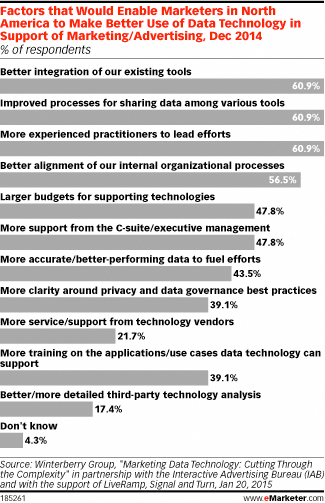Why Do Marketers Find the Cloud Dreamy?
March 7, 2015
![]() Technologies to create, manage and measure marketing and advertising have become essential tools to reach and engage increasingly connected audiences. As a result, in addition to being brand builders and message crafters, modern marketers now also wear the hat of technologist, according to a new eMarketer report, “Marketing Technology: Nine Important Trends for Brands and Agencies in 2015.”
Technologies to create, manage and measure marketing and advertising have become essential tools to reach and engage increasingly connected audiences. As a result, in addition to being brand builders and message crafters, modern marketers now also wear the hat of technologist, according to a new eMarketer report, “Marketing Technology: Nine Important Trends for Brands and Agencies in 2015.”
 Through piecing together the products, platforms, solutions, suites, stacks and other analogs for the software and services that help power their operations, marketers have become more seasoned and strategic with their approach to marketing technology. Even so, the technological landscape continues to grow and advance at breakneck speed, posing new challenges as marketers work to assimilate newfound capabilities.
Through piecing together the products, platforms, solutions, suites, stacks and other analogs for the software and services that help power their operations, marketers have become more seasoned and strategic with their approach to marketing technology. Even so, the technological landscape continues to grow and advance at breakneck speed, posing new challenges as marketers work to assimilate newfound capabilities.
 Cloud-based software in particular has helped marketers be more agile and experiment with new channels and tactics. A bevy of tech providers have even adopted the “marketing cloud” moniker to position and promote their vision of a truly integrated marketing software system, causing intrigue but also some consternation among users.
Cloud-based software in particular has helped marketers be more agile and experiment with new channels and tactics. A bevy of tech providers have even adopted the “marketing cloud” moniker to position and promote their vision of a truly integrated marketing software system, causing intrigue but also some consternation among users.
In essence, cloud-based software is developed and deployed via the web. Instead of having to buy, install, upgrade and maintain software on individuals’ computers or in-house servers, users can often create an account and start playing around with the software immediately via their internet browser.
The cloud indeed makes it easier than ever before for marketers to take advantage of new software platforms. At the same time, the pressure to measure marketing’s effectiveness, use systems more efficiently and deliver more seamless experiences means that integration is a top priority.
In August 2014 research from Econsultancy and Teradata, the top criterion marketers worldwide considered when evaluating new technologies was full integration with other technologies. Privacy and data security was a close second.
Many marketers and agencies also believe that better integration of their existing tools and improved processes for data sharing across those tools would help them more effectively take advantage of their existing technology investments, per December 2014 polling by Winterberry Group and the Interactive Advertising Bureau.
By several measures, marketers have made progress when it comes to integration, but many still believe there’s further room for improvement. Just 4% of US marketers reported having a completely integrated marketing stack in Signal’s September 2014 research. While 21% of respondents said most of their tools were integrated, and 24% had their core tools integrated, the situation for 41% of marketers was only “some” integration.
Courtesy of eMarketer




























